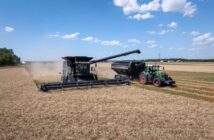Growers have a valuable opportunity to keep a lid on the UK’s major winter wheat disease of Septoria tritici and protect yield in this season’s late-planted crops, says a leading ADAS expert. But new ADAS research has underlined the importance of not squandering this by applying fungicides too late.
According to ADAS principal research scientist, Jonathan Blake, although early-drilled crops are at increased pressure from Septoria tritici, later sowings are more likely to see reduced Septoria tritici pressure, due to carrying less infection out of the winter.
That should make it easier to stay on top of the disease with the correct, preventative fungicide strategy, he says. In addition, shortened intervals between upper leaf emergence, as late crops grow rapidly to catch up, could help them ‘outgrow’ Septoria in the crop base, he suggests.
“Rapid leaf emergence is likely to help crops escape disease progress,” says Mr Blake. “We are likely to end up with crops that require more protectant than curative disease control, because disease won’t have established so much.”
Although Septoria in late crops cannot be ruled out, Mr Blake believes it puts growers in a much stronger position to curb its spread up the top three yield-building leaves, but it will be important that fungicides are applied on time.
Highlighting this, glasshouse research by ADAS for Syngenta comparing different SDHI + azole fungicides last year, showed much better Septoria tritici control where treatments were applied preventatively, seven days before leaves were infected with the disease, than where treatments were applied curatively, seven days after. This was still evident some seven weeks after application, with the greatest preventative control of the experiment’s Septoria tritici population coming from the SDHI + azole fungicide, Elatus Era.
However, while Septoria tritici pressure may be low in this year’s late-planted crops, Mr Blake says there is good evidence that yellow rust could be more problematical – especially since a fair proportion could have been planted with a susceptible variety.
Mr Blake says: “There is evidence that wheat plants become more resistant to yellow rust as more leaves emerge. A later-planted crop will have fewer leaves, so if disease resistance increases with leaf emergence, fewer leaves equals less resistance.”
Syngenta disease control specialist, David Ranner, agrees and says because late-planted crops only have a short growing season, they go through growth stages more quickly, producing fewer leaves on each stem.
“This not only makes it important to be alert to yellow rust,” says Mr Ranner, “it also makes it important to check crop growth stages regularly, so that fungicides are applied on time. Late application automatically puts fungicides in a more curative situation, and we saw clearly in the ADAS research that SDHI + azole fungicides performed best when applied preventatively.
“It is well worth considering using Elatus Era in fungicide programmes once this season. It is very strong on yellow rust and the ADAS work showed it was long-lasting against the Septoria population in the experiment.”




